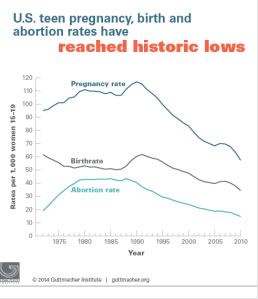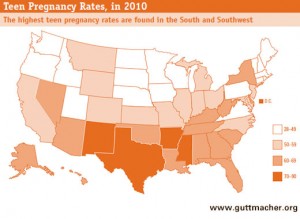The Plunge in Teen Pregnancy Rates
May 6th, 2014 | By admin | Category: Family PlanningBy Suzanne York, www.howmany.org
The number of American teenagers getting pregnant is at an historic low. While this is good news, the U.S. teen birth rate is still highest in the industrialized world.
Rates of teen pregnancy, birth and abortion have declined dramatically in the United States since their peak in the early 1990s. According to the Guttmacher Institute, teen pregnancy rates declined in every state and among all racial and ethnic groups. Yet, increasing proportions of 18–19-year-olds reported having ever had sex, but fewer of them became pregnant.
The Benefits of Less Sex and More Contraception
When asked why this has happened, Bill Albert, the chief program officer of The National Campaign to Prevent Teen and Unplanned Pregnancy said “The short answer is that it is a combination of less sex and more contraception. Teenagers have a greater number of methods of contraceptives to choose from.”
And yes, maybe even television has made an impact. A study earlier this year by the National Bureau of Economic Research, found that the MTV show “16 and Pregnant” ultimately led to a 5.7% reduction in teen births in the 18 months after its premiere on TV.
Fast Facts:
- In 2010, some 614,000 pregnancies occurred among teenage women aged 15–19, for a rate of 57.4 pregnancies per 1,000 women that age – a 51% decline from the 1990 peak, and a 15% decline in just two years, from 67.8 in 2008;
- the pregnancy rate among teenagers was 57.4 pregnancies per 1,000 women – approximately 6% of teens became pregnant in 2010;
- the teenage birthrate in 2010 was 34.4 births per 1,000 women – this is 44% lower than the peak rate of 61.8, reached in 1991;
- the teen abortion rate declined 66% between its 1988 peak and 2010 (from 43.5 abortions per 1,000 to 14.7 per 1,000).
Although there have been dramatic declines in teen pregnancy rates among all racial and ethnic groups, Guttmacher reported that wide disparities still persist, and rates among both black and Hispanic teens remain twice as high as the rate for non-Hispanic white teens.
Looking at state specific data, in 2010, New Mexico had the highest teenage pregnancy rate (80 pregnancies per 1,000 women); the next highest rates were in Mississippi (76), Texas (73), Arkansas (73), and Louisiana (69). The lowest rates were in New Hampshire (28), Vermont (32), Minnesota (36), Massachusetts (37) and Maine (37).
Family Planning: A Good Return on Investment
Lydia DePillis, writing for the Washington Post’s Wonkblog, posted an article last week entitled “The U.S. still spends way more on teen pregnancy than family planning.” She noted that “the National Campaign to Prevent Teen and Unplanned Pregnancy just released a total accounting of all the extra money the public spent on teen mothers in 2010, the most recent year for which figures are available: $9.4 billion.” Compare $9.4 billion to what public funds are spent on family planning – $2.37 billion (in fiscal year 2010).
Interestingly, DePillis links to another articleon how children lead to greater economic growth, and if teen pregnancies are at historic low this will have economic repercussions. This is just completely the wrong way to address this topic. Lowering teen pregnancy and reducing the chances of unwanted pregnancy for all – and keeping teens in school – should be the societal goal.Equating more kids with more economic growth is missing the big picture – there are 314 million people in the U.S., over 7 billion in the world, and likely to be over 9 billion in just a few decades. The mantra of ever more economic growth (which of course relies on ever more people), is a tired and unrealistic theme on a planet of finite resources. What is needed is to rethink how to structure economies in a way that promotes health and well-being, education, sustainable livelihoods, and a clean environment.
A reduction in teen pregnancy should be seen as a good thing, and not a dire prediction on the economy.
Suzanne York is a senior writer with the Institute for Population Studies.



